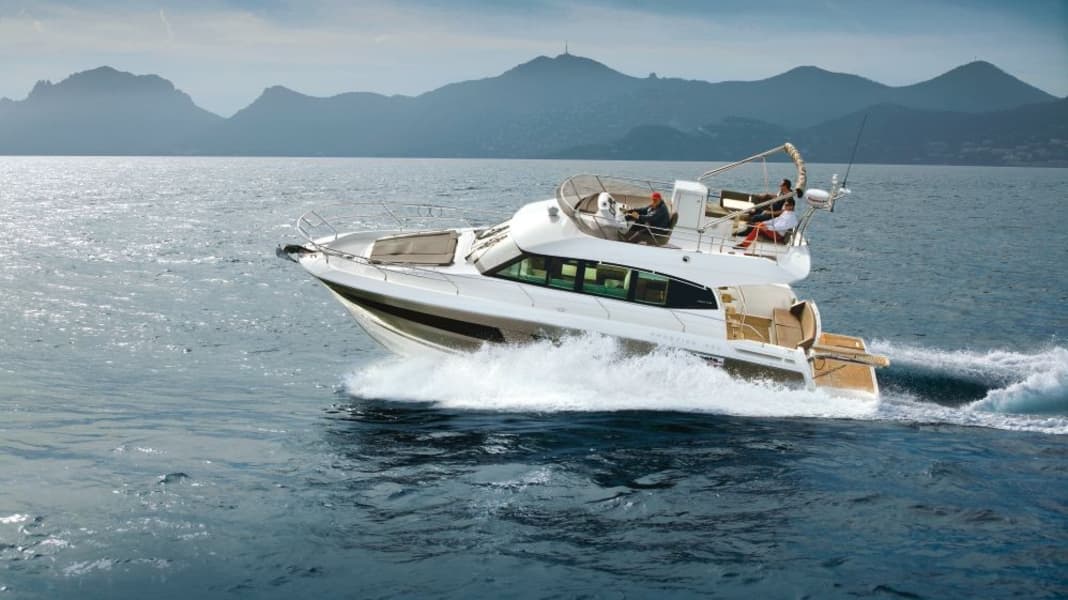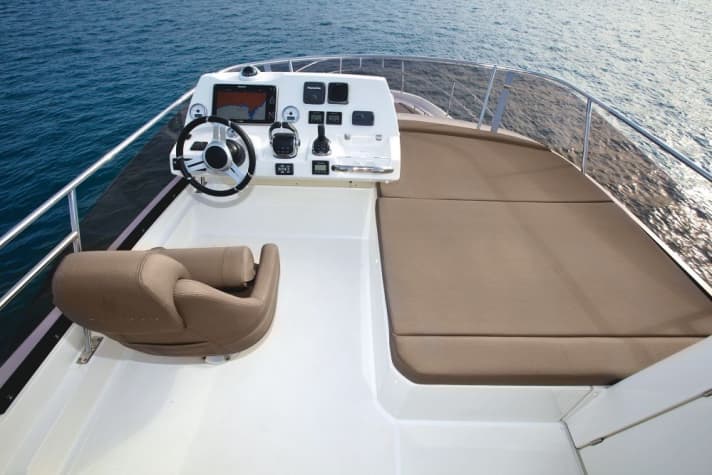
Jeanneau is one of the big names in Europe and made a good name for itself back in the sixties. Today, the shipyard is part of the Beneteau Group. As Jeanneau also has boats with flybridges in its programme, it established its own brand at an early stage in order to differentiate itself and be able to compete in the upper class. It bears the distinctive name Prestige and is available in yacht, coupé or fly versions. Our test boat belongs to the flybridge group and, at just under 13 metres in length, is the smallest or, in other words, the entry-level model in the "Prestige world".

As far as the quality of the test boat is concerned, the self-imposed requirement matches the result so far. The exterior and interior plastic work is okay. The fact that not all the plastic cut edges are treated, such as those of the engine compartment cut-out, is only noticeable when you stand in it or bump into the cut edge.
There is still some catching up to do in terms of the furniture in the saloon, with some areas lacking the finishing touches. On the other hand, the technical and electrical installations are impressive. The emergency switches for the remote-controlled main battery relays are located in an exemplary manner together with the fuses in a cabinet in the companionway to the centre cabin. However, the lack of water alarm sensors on the fuel pre-filters is criticised.
What is special about the 420 Fly in this class, however, is that it does not have a third cabin. This guarantees two spacious cabins and allows for generously designed bathrooms. In addition, the door design in the forward cabin allows a longer berth to be installed at the customer's request, which significantly improves sleeping comfort for particularly tall crew members.
The real highlight, however, is that the second cabin under the saloon and aft from the latter has its own access. This is a luxury, and not just because it creates the greatest possible privacy. The space on the entire boat is also more than impressive. For example, the table on the dinette can be lowered electrically to create additional berths if required. And if you want to dine outside, you can go to the flybridge or simply into the cockpit. Sun-seekers can stretch out on the foredeck and up on the fly.
Engines and IPS drives from Volvo Penta are used as drive units. Two IPS400s with 300 hp compression-ignition engines do their job as standard. We go one size up: two IPS500s with 370 hp each in front. IPS drives have the advantage that they can be steered at low speed using joysticks, which makes manoeuvres in confined spaces easy. You can move the boat in any direction, which makes mooring and casting off easier. In the harbour, we perform manoeuvres at slightly higher speeds and slow passages at 6 knots so that the waves generated by the boat do not interfere.
Visibility remains good during the transition from displacement to planing speed, while the test boat begins to plane from 11 knots. Only when cornering to port is visibility at the saloon helm restricted to the side, as the saloon roof swivels into the field of vision. Over starboard it fits again, you just have to bend down a little. When travelling aft, you can only see water.
At full throttle, the engines turn 100 rpm more than the manufacturer allows, and the GPS logs 32 kn as the maximum speed. For economical cruising, however, the diesels only need to turn between 3000-3400 rpm in order to theoretically cover almost 200 nm on one tank of fuel at speeds between 23-29 kn. That's not enough for us; if you want to go further, you have to drive as a displacer.
The turning angles of IPS drives are determined by the rpm and speed, which is why curves in gliding manoeuvres are associated with large diameters. If you want to turn tighter, you have to go slowly, which is one reason why extreme manoeuvres are not possible and we are skipping this chapter. Only on the imaginary slalom course can the 420 Fly be moved slightly over its longitudinal axis if you turn the rudder fast enough. The 420 masters rough water with waves up to about one metre high on the Mediterranean with flying colours in all directions.
Prestige boats are equipped ready to sail - the standard package fits the bill. Other comfort and the fulfilment of individual equipment requirements are provided by equipment packages put together by the shipyard and a well-stocked list of accessories.






Data sheet: Prestige 420 Fly
Shipyard: Jeanneau
Type designation: Prestige 420 Fly
CE category: B - Outside coastal waters
Material of hull and deck: Plastic
Length: 12,64 m
Width: 3,97 m
Displacement: 9,22 t
Price: 433.041,00 €

